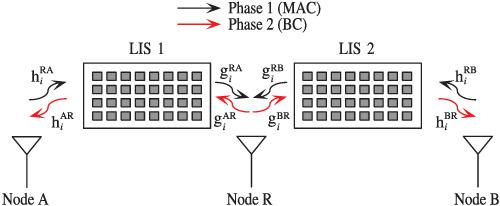当前位置:
X-MOL 学术
›
Int. J. Commun. Syst.
›
论文详情
Our official English website, www.x-mol.net, welcomes your
feedback! (Note: you will need to create a separate account there.)
Large intelligent surfaces: Random waypoint mobility and two‐way relaying
International Journal of Communication Systems ( IF 1.7 ) Pub Date : 2020-07-07 , DOI: 10.1002/dac.4505 Narushan Pillay 1 , Hongjun Xu 1
International Journal of Communication Systems ( IF 1.7 ) Pub Date : 2020-07-07 , DOI: 10.1002/dac.4505 Narushan Pillay 1 , Hongjun Xu 1
Affiliation

|
In this paper, we first investigate the effect of mobility via the random waypoint (RWP) mobility model on the performance of nonaccess point (non‐AP) or AP large intelligent surfaces (LISs). The theoretical average bit error probability (ABEP) for each of these LISs under mobility is formulated. The presented formulation is complicated to solve; hence, the trapezoidal approximation is employed. Simulation results serve to validate the ABEP. Second, we investigate a two‐way relaying (TWR) network assisted by non‐AP or AP LISs. A network with two source/destination nodes with a single relay node employing decode‐and‐forward placed between these nodes is considered. The transmission interval is broken into two transmission phases. In the first phase, the two source nodes transmit information blocks to the relay node assisted by LISs. On receiving these information blocks, the relay node decodes the two information blocks and encodes these into a single information block via the use of network coding. In the second phase, the relay node forwards the network‐coded information block to the destination nodes assisted by LISs, where the intended information block is decoded via network coding. The theoretical ABEP is formulated for the proposed non‐AP and AP LIS‐assisted TWR schemes and is validated by simulation results. RWP mobility is also demonstrated for the proposed TWR schemes.
中文翻译:

大型智能地面:随机航点移动性和双向中继
在本文中,我们首先研究通过随机路点(RWP)流动性模型对非接入点(non-AP)或AP大智能曲面(LISs)性能的影响。公式化了这些LIS在迁移率下的理论平均误比特率(ABEP)。提出的公式难以解决;因此,采用梯形近似。仿真结果有助于验证ABEP。其次,我们研究了非AP或AP LIS辅助的双向中继(TWR)网络。考虑具有两个源/目标节点和一个中继节点的网络,该中继节点采用在这些节点之间进行解码和转发。传输间隔分为两个传输阶段。在第一阶段,两个源节点在LIS的帮助下将信息块发送到中继节点。在接收到这些信息块时,中继节点对两个信息块进行解码,并通过使用网络编码将它们编码为单个信息块。在第二阶段,中继节点将网络编码的信息块转发到借助LIS辅助的目的节点,在此处通过网络编码对目标信息块进行解码。理论ABEP是为拟议的非AP和AP LIS辅助TWR方案制定的,并通过仿真结果进行了验证。还针对拟议的TWR方案演示了RWP的移动性。通过网络编码对预期的信息块进行解码。理论ABEP是为拟议的非AP和AP LIS辅助的TWR方案制定的,并通过仿真结果进行了验证。还针对拟议的TWR方案演示了RWP的移动性。通过网络编码对预期的信息块进行解码。理论ABEP是为拟议的非AP和AP LIS辅助的TWR方案制定的,并通过仿真结果进行了验证。还针对拟议的TWR方案演示了RWP的移动性。
更新日期:2020-07-07
中文翻译:

大型智能地面:随机航点移动性和双向中继
在本文中,我们首先研究通过随机路点(RWP)流动性模型对非接入点(non-AP)或AP大智能曲面(LISs)性能的影响。公式化了这些LIS在迁移率下的理论平均误比特率(ABEP)。提出的公式难以解决;因此,采用梯形近似。仿真结果有助于验证ABEP。其次,我们研究了非AP或AP LIS辅助的双向中继(TWR)网络。考虑具有两个源/目标节点和一个中继节点的网络,该中继节点采用在这些节点之间进行解码和转发。传输间隔分为两个传输阶段。在第一阶段,两个源节点在LIS的帮助下将信息块发送到中继节点。在接收到这些信息块时,中继节点对两个信息块进行解码,并通过使用网络编码将它们编码为单个信息块。在第二阶段,中继节点将网络编码的信息块转发到借助LIS辅助的目的节点,在此处通过网络编码对目标信息块进行解码。理论ABEP是为拟议的非AP和AP LIS辅助TWR方案制定的,并通过仿真结果进行了验证。还针对拟议的TWR方案演示了RWP的移动性。通过网络编码对预期的信息块进行解码。理论ABEP是为拟议的非AP和AP LIS辅助的TWR方案制定的,并通过仿真结果进行了验证。还针对拟议的TWR方案演示了RWP的移动性。通过网络编码对预期的信息块进行解码。理论ABEP是为拟议的非AP和AP LIS辅助的TWR方案制定的,并通过仿真结果进行了验证。还针对拟议的TWR方案演示了RWP的移动性。











































 京公网安备 11010802027423号
京公网安备 11010802027423号